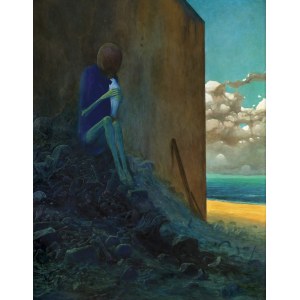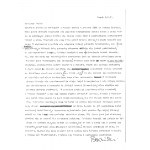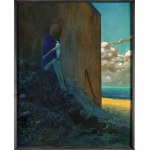122.0 x 99.0 cm - oil, fiberboard signed on the back p.d.: BEKSIŃSKI | 1973
Reproduced painting:
- Wieslaw Banach, Zdzislaw Beksinski. Antologia Twórczości cz. 3 - malarstwo okres fantastyczny, Rzeszów 2009, p. 62, il. black and white.
The presented painting belongs to the so-called fantastic period, which brought Beksinski recognition and popularity. In his works from the 1970s, the artist often uses motifs with content that could be interpreted according to a literary-symbolic key, referring to the climate of Romanticism or symbolism from the turn of the 19th and 20th centuries, but Beksinski himself tried to convince in his statements, during interviews conducted with him, that meaning is meaningless to him, and the motifs contained in these paintings should not be subjected to a simple literary interpretation. This is also the case with the painting presented with us, in which we see the figure of a child in the ruins, hugging a white bird in a scene where the space in the foreground - filled with destruction and emptiness - is adjacent to a gentle sea shore under a serene sky.
A letter from Zdzislaw Beksinski dated February 2, 1976, addressed to the first buyer of the painting has survived. The artist wrote: Dear Sir! Thank you very much for the news about the purchase of the painting [...] So many of my paintings go completely nameless when it comes to the people who acquired them, that I am always very happy to be able to locate at least approximately one of them. Unfortunately I cannot give you the title of the painting, because I never give titles. Most of the time I do not feel any need to title, while in those RARE cases where I feel such a need, however, I try to restrain myself so as not to create confusion. I have similar difficulties in explaining the content of images. E.g., I myself do not know whether the child painted in the picture purchased by you is a girl or a boy! The question of gender was probably indifferent in this case, but undoubtedly it was about a child. I never operate with symbolism, and even if there are objects in the painting that can be regarded as certain popular symbols (such as a white bird), they were not introduced on the basis of a symbol in the traditional sense of the word. In creating a painting, I am guided primarily by a vision that is quite irrational and has no utilitarian significance in relation to any literary content that I could or would convey through the painting. In fact, I'm going for mood and "spiritual expression" before anything else, if that term means anything at all. Please forgive me if this explanation is inadequate, but there is nothing more I can add. Besides, I am explaining, because I know that it always raises questions as to why I sign the paintings backwards. This matter, as I noted, usually raises doubts, and meanwhile the explanation is simple. According to my own opinion on the subject, I have a nasty handwriting. When a painting is finished I am afraid to spoil it with a poorly placed signature. Deciding whether the signature should be light on a dark background or dark on a light background, whether it should be left or right or in the middle, is beyond my mental toughness! That's why I sign from the back. That's all. I will be very happy if you would like to visit me in Sanok with spring or whenever. I bow to you beautifully and greet you warmly. Beksinski
♣ a fee will be added to the auctioned price, in addition to other costs, based on the right of the creator and his heirs to receive remuneration in accordance with the Law of February 4, 1994 - on Copyright and Related Rights (droit de suite).
Zdzislaw Beksinski (Sanok 24 II 1929 - Warsaw 21 II 2005) studied from 1947 to 1952 at the Faculty of Architecture of the Cracow University of Technology.
He was a self-taught artist who achieved an unquestioned position in Polish contemporary art, confirmed by the presence of his works in prestigious exhibitions and museum collections. He was initially involved in photography, which he had been interested in since his student years, after 1956 gaining recognition as a creator of photograms with an aesthetic based on textural effects. In 1958-1962, he created abstract paintings-reliefs of rich texture, mainly metal, which are a variation of matter painting. Toward the end of this period, he created openwork forms with figure shapes and full-bodied sculptures in metal. The next stage of his work was 1962-1974, when he devoted himself mainly to drawing. In the 1960s he drew with pen and ink figural compositions characterized by caricatured deformation of figures. From the late 1960s, he created charcoal and crayon drawings, a monochromatic variant of his parallel painting work. Since 1974, he has dealt almost indivisibly with painting. His distinctive style was based on technical perfection, accompanied by an extraordinary vision. He painted a post-disaster world, marked by the stigma of death and decay. His paintings are populated by figures and creatures with admittedly human or animal shapes, but with the characteristics of phantoms, automatons or decaying corpses. The artist did not give his paintings and drawings titles (except for ordering symbols), thus emphasizing his lack of interest in the literary side of the depictions. He himself said that when painting he completely surrenders to the vision, "photographing" it. In recent years, he has incorporated electronic image generation techniques into his artistic technique, which he used to create computer photomontages. Beksinski's art, which has been exhibited and discussed many times, arouses extreme emotions among experts and the public.
The largest, systematically replenished collection of his works in the country is in the Historical Museum in Sanok, abroad - in Paris, in the possession of Piotr Dmochowski, who has been collecting works and promoting the artist's work since 1983. He organized individual exhibitions of Beksinski's works at, among others, Galerie Valmay in Paris in 1985, 1986 and 1988, as well as a permanent exhibition at Dmochowski's own Galerie - Musée-galerie de Beksinski, which existed from 1989 to 1996. He also published monumental albums of the artist in 1988 and 1991.
In Poland, Beksinski's monograph by Tadeusz Nyczek was published by Arkady in 1989 (second edition in 1992). In the spring of 2005, a large exhibition of Beksinski's paintings took place at the Abbotsford Palace in Gdansk Oliva, and the director of the Sanok Museum Wieslaw Banach published a comprehensive monograph on the artist.
Since October 2016, an exhibition of 250 works (paintings, drawings, photographs) by Zdzislaw Beksinski from the private collection of Anna and Piotr Dmochowski has become a permanent fixture at the Nowa Huta Cultural Center. Meanwhile, a permanent exhibition of 30 Beksinski paintings from the Dmochowskis' collection has also been on display at the Archdiocese Museum in Warsaw since June 2021.
Recently viewed
Please log in to see lots list
Favourites
Please log in to see lots list














